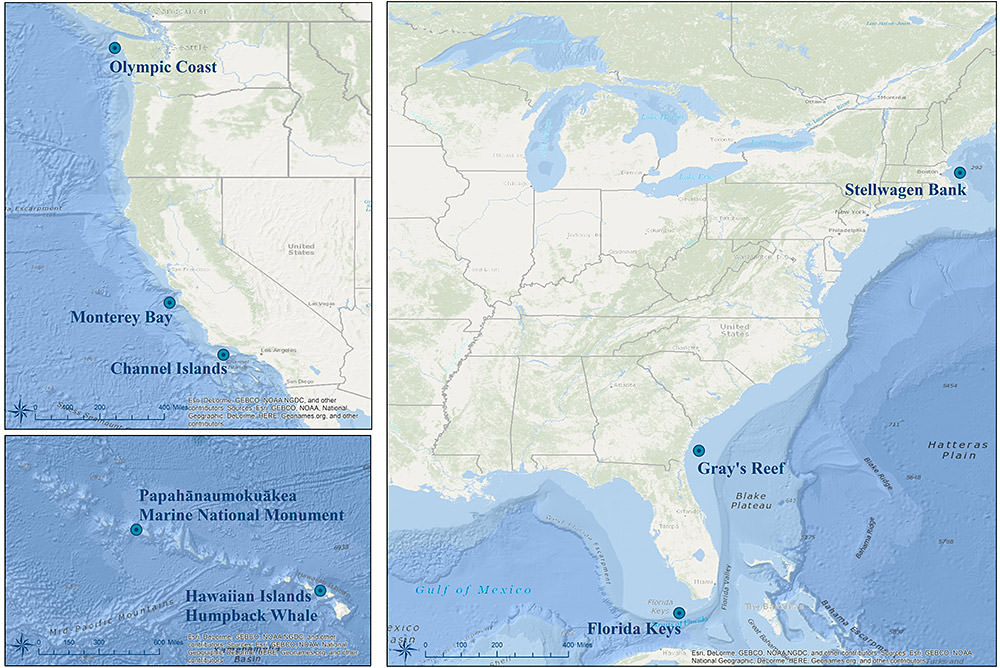Humpback Whale Sound Production Recorded at Monterey Bay Aquarium Research Institute Monterey Accelerated Research System
This record represents humpback whale detection from recordings at the Monterey Accelerated Research System (MARS) cabled observatory. MARS resides on the continental slope outside Monterey Bay, California at a depth of 890 m. It's location is in the center of Monterey Bay National Marine Sanctuary. Since 28 July 2015, MARS has supported nearly continuous sound recording at a sample rate of 256 kHz. Long term spectral averages with a resolution of 5 seconds/1 Hz were manually scanned using consistent intensity and contrast settings throughout the time-series. Visual detections were paired with model scores from the NOAA / Google humpback song detector (Allen et al., 2021). Aural verification of the recording was used when analysts were uncertain of the result. The analysis period for these detection is standardized across SanctSound sites to allow for direct comparison.These data were recorded at SanctSound Monterey Accelerated Research System between November 01, 2018 and October 31, 2020.
- Cite as: NOAA Office of National Marine Sanctuaries and U.S Navy. 2021. Humpback Whale Sound Production Recorded at Monterey Bay Aquarium Research Institute Monterey Accelerated Research System, SanctSound Data Products. NOAA National Centers for Environmental Information. https://doi.org/10.25921/336w-4898. [access date].
- 10.25921/336w-4898
- NCEI Metadata ID: gov.noaa.ncei.pad:NOAA-Navy-SanctSound_MARS_humpbackwhale_1d
gov.noaa.ncei.pad:NOAA-Navy-SanctSound_MARS_humpbackwhale_1d
| Download Data |
|
| Distribution Formats |
|
| Ordering Instructions | Contact NCEI for other distribution options and instructions. |
| Distributor | NOAA National Centers for Environmental Information
ncei.info@noaa.gov |
| Dataset Point of Contact | NOAA National Centers for Environmental Information
ncei.info@noaa.gov |
| Dataset Point of Contact | Carrie Wall
NCEI Passive Acoustic Archive Lead NOAA National Centers for Environmental Information pad.info@noaa.gov |
| Coverage Description | Monterey Accelerated Research System |
| Time Period | 2018-11-01T00:00:00Z to 2020-10-31T23:59:59Z |
| Spatial Bounding Box Coordinates |
N: 36.713
S: 36.713
E: -122.186
W: -122.186
|
| Spatial Coverage Map | |
| General Documentation | |
| Associated Resources |
|
| Publication Dates |
|
| Edition | Mar 2020 Data Products (Oct 2018-Dec 2019) |
| Dataset Progress Status | Complete - production of the data has been completed |
| Data Update Frequency | As needed |
| Purpose | These data are available to the public for a wide variety of uses including scientific research and analysis. |
| Dataset Citation |
|
| Cited Authors |
|
| Principal Investigators |
|
| Collaborators |
|
| Publishers |
|
| Acknowledgments |
|
| Theme keywords | Global Change Master Directory (GCMD) Science Keywords
|
| Data Center keywords | Global Change Master Directory (GCMD) Data Center Keywords
|
| Platform keywords | Global Change Master Directory (GCMD) Platform Keywords
|
| Instrument keywords | Global Change Master Directory (GCMD) Instrument Keywords
|
| Place keywords | Global Change Master Directory (GCMD) Location Keywords
|
| Project keywords | Global Change Master Directory (GCMD) Project Keywords
|
| Use Constraints |
|
| Access Constraints |
|
| Other Constraints | Cite as: NOAA Office of National Marine Sanctuaries and U.S Navy. 2021. Humpback Whale Sound Production Recorded at Monterey Bay Aquarium Research Institute Monterey Accelerated Research System, SanctSound Data Products. NOAA National Centers for Environmental Information. https://doi.org/10.25921/336w-4898. [access date]. |
| Fees |
|
| Processing Steps |
|
| Instrument |
|
| Platform |
|
Last Modified: 2022-02-10
For questions about the information on this page, please email: ncei.info@noaa.gov
